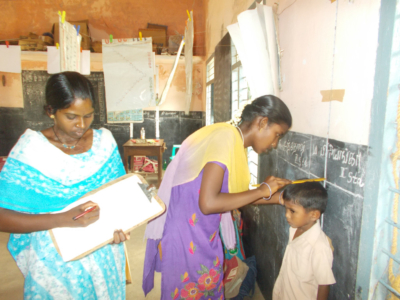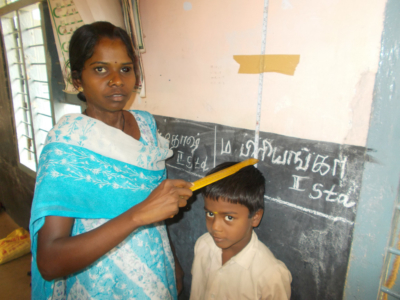After many years of routine life, where a woman reaches puberty, gets married after a few years, faces male chauvinistic husband and his family, works for the family, begets children and brings them up, she gets to learn about her body for the first time for her surprise….
Our Health Workers (HWs) take pride in gaining basic health, clinical, and medical knowledge and transferring the same to the children, adolescent girls and older women, through their regular school and street meetings at their villages. They take their videos, pamphlets, prepare their charts and notes to deliver their health education classes on a monthly schedule. They talk about understanding body, nutrition, hygiene, female reproductive health, prevention and home management of common illness and so on.
Having a health auxiliary (HA) in a village means earl diagnosis and early intervention of health problems. By means of HW’s house visits and people approaching HAs, a HA gets to know that someone is ill in the village. She visits the family; identifies the problem; addresses herself if the problem is a simple one; brings them to Payir Health center if its beyond her level; if the sick needs a secondary or tertiary care, they are referred to a known doctor of particular specialty, who is a part of the trusted referral network Payir has developed over years. Since health auxiliaries are a part of the community, they would also be more accessible at any time compared to an outsider.
Payir believes in strengthening public systems and hence has built a network of majority doctors from public services. HAs accompany the needy villager to the right doctor for their problem, and the doctor who understands the ground reality of the people we take, she / he gives rational, affordable treatment solutions. Thus doctor hunting and huge unnecessary expenditure on private hospital’s misguided treatments are avoided.
The idea of this program is to develop a dynamically evolving self-sustaining healthcare model that addresses the core issues efficiently. Our realization that intervention at the community level by the local people would be beneficial in the long run provided the impetus to set up a pilot program where healthcare delivery is done by people who hail from the community that is being addressed to. This would help in a great extent to offset the shortage of professional and paramedical personnel.
Secondly, since they are more culturally acceptable they would be more effective in delivering health education aspects since health education is a very crucial yet most neglected component of medical services. Moreover, health education by the village health auxiliaries involves propagation of specific, predetermined messages and is intellectually not a very demanding task like diagnosis and management of a whole of variety of ailments. Hence this task can be easily carried out by a layperson after a short course of training that is sufficient to teach the basics of health education to a village health auxiliary. The additional, specific advantage of health education done through the HAs is that HAs can present the health messages in a language and in the cultural context which people can understand. They can even modify the message in a better way than an ‘educated’ outsider can do. Their knowledge on certain indigenous practices which are medically valuable can also be utilized in a proper manner. Above all, they would be in a far better position to elicit people’s cooperation for community action on health issues and the general health of the community. Therefore, they can serve as community organizers, as has been seen in many health projects.
Posted at:
